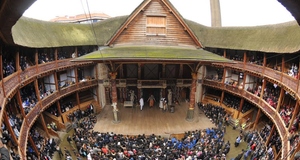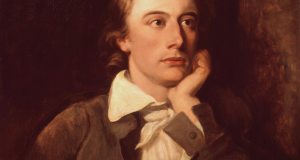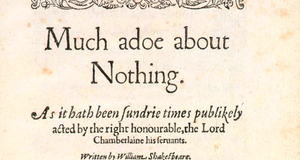Review of John Bernard's Theatricality and Textuality: The Example of 'Othello'
By
2010, Vol. 2 No. 12 | pg. 1/1 Work for Review:
Bernard, John. “Theatricality and Textuality: The Example of ‘Othello’.” New Literary History 26.4 ‘Philosophical Resonances’ (Autumn, 1995) 931-949. http://muse.jhu.edu/login?uri=/journals/new_literary_history/v026/26.4bernard.html Bernard begins his article by identifying the friction that exists between the performed text and that which appears in print, or more precisely, the opposing scholarly positions that such a division creates; he indicates that the affinity between these two approaches to reading dramatic texts, that is the “text-centred and stage-centred” (931), is not often recognised. While it stands to reason that a text designed for playing upon the stage will contain elements of meaning that are not present in its written form, Bernard is nevertheless confronted with the problem of theoretically discussing the staging of Othello without moving his argument into the terms of conjecture. To put it another way, Bernard was not there during the Renaissance when Othello was first performed, nor does his article make use of Renaissance period prompt copies or reports of performance. How then does Bernard manage to demonstrate the effects of locus and platæa without making assumptions about decisions made in the Renaissance staging of the play? The answer lies in Bernard’s detailed yet concise literature review, which makes up the second section of his article, and it is on this section that I focus this critical review, as Bernard lays the groundwork to ensure that his later analysis of Iago in Othello does not collapse. Overall, Bernard structures his article in an easily detectable, yet effective, way: introduction, context, analysis and exposition. Stylistically, Bernard is careful to signpost the reader through his argument, and in his literature review in section two, while containing a large number of scholars and their works and often dealing with contrary positions, he manages to systematically work through his bibliography creating firm links between different scholars. In reading section two, one is almost treated to the development of Bernard’s understanding of his topic and the pre-existing scholarship. It is almost as if Bernard takes the many different facets of criticism explored here, and draws them together to prove his thesis; Bernard’s analysis of Iago simultaneously requires and is made possible by this theoretical grounding. That is to say, in this article a performative reading of Othello is both permitted and is made necessary by the theory. It is imperative to his argument that Bernard establishes the validity (indeed, superiority) of the text-in-performance as opposed to the text-in-text, for in this context, “the theatrical texts” conscious deployment of space and the attendant antimemetic conventions of the platform stage” (932) must become analogous with the same process as it occurs in the written. Bernard begins to accomplish this through equating the “meta-representative” techniques evident in written texts, such as, he suggests, the work of Montaigne, with theatrical practice. In effect, this meta-representation, or “mimesis of mimesis,” (932) focuses the reader’s attention upon the text’s own representation of meaning, demonstrating the active fiction of the text itself. The transition into Bernard’s summary of prior scholarship is quite abrupt, but he takes care to reassure the reader that the Shakespearean analysis is forthcoming. The end of section one definitively states the purpose of the article (which Bernard accomplishes in the penultimate third section) but this next section interjects with its discussion of critical framework. The reassurance is perhaps necessary as Shakespeare is not mentioned at all until the final two paragraphs of the section, however by this time, due to Bernard’s lucid and comprehensive census of scholars, the theories and perspectives mentioned seem naturally to fall in to place. Bernard’s discussion and analysis of Iago, and his function within Othello, is not the traditional text-based reading, and the extensive foregrounding of section two is necessary to prove the validity of the ‘performance text’ over the written ‘dramatic text’ – else Bernard’s reading in section three would be considered pure conjecture.Bernard extensively cites Weimann to explore the idea of theatrical mimesis in the renaissance. Disguised in paragraph one is the crux of Bernard’s later analysis of Othello, Weimann’s earlier scholarship provides much of the theory behind Bernard’s approach: namely that the “material conditions of the Elizabethan theatre” (933) allow for the actors upon the stage to break with the action and engage with the audience themselves in the construction of the plays meaning. This “distribution of space” (933) as discussed by Bernard, is really Weimann’s delineation of the Renaissance stage into the locus and platæa; this becomes a key rhetorical point later in Bernard’s analysis, namely that Iago serves as a mediator between the play and the audience by soliloquising on the physical platæa – hence serving a platæic function in the text. It is worth noting here that a particular flaw in Bernard’s rhetoric exists in not having an explicit definition for his appropriation of Weimann’s terms, so extensively used in section three. Weimann’s (and other’s) study into the topology of the Elizabethan stage is discussed at this early point, but all of a sudden, in section three, we are confronted with “Iago’s dominance of the nonrepresentational mimesis of the platæa…” (938). While a knowledgeable reader in the field of Renaissance drama will likely have met with Weimann’s particular use of the terms, here Bernard is employing the terms to signify a textual purpose, so to avoid potential confusion a simple footnote citing the adaptation of the terms to their theatrical meanings would not have gone astray. While paragraph i deals with the historical aspects of both Bernard and Weimann’s criticism, paragraph ii explores the wider social implications; the former demonstrates how meta-representative practices are embedded in theatrical texts, the latter begins to explain why they are there. The paragraph also serves to further the opposition indicated in the Introduction: that is, the textual vs. performative readings. Weimann is again employed to show the mimetic similarities between the text and the performance, especially in their shared recognition of their own processes. Essentially, Weimann’s “new mimesis” (934) is not sufficiently explored with pre-existing terms, therefore Bernard finds it necessary to redefine and imbue ‘theatricality’ with greater meaning, validating it as a theoretical perspective. In moving on to a review of Maclean’s scholarship (paragraph iii) Bernard is adding more voices to the scholarly cry for a recognition of “the relationship between narrative and theatre” (note 6, p944-5, after Maclean), and while she is not a Shakespearean critic per se, Maclean’s treatment of narrative-as-theatre validates Bernard’s reading of Othello as text-in-performance. This is further confirmed by a semiotic reading of theatre, which Bernard explores in paragraph iv. Uncharacteristically, in his recitation of these semioticians, Bernard’s style seems more hesitant in his discussion of their theories than other scholars mentioned prior; the note after Bernard’s summary of Ubersfeld is particularly reserved (note 29, p947). While Maclean takes the narrative and turns it into a performance, Ubersfeld’s approach seems to be the reverse, imbuing the theatrical act with narrative properties. However, the two scholars in such proximity creates a confusion of terms, and it seems to me that here Bernard’s logic falters: if we can equate the narrative text with the theatrical, what then is the difference between the “reader-as-spectator” and the “spectator-as-reader.” (935) If both positions are involved in the same experience of creating meaning, then surely the two roles are analogous? Both theories position the reader/spectator as simultaneously outside and within the action of the play or narrative, thus occupying a position that both creates and receives meaning. Nevertheless, the key quote from Ubersfeld is that “the discourse of the playwright makes sense only as theatricality,” (935, after Ubersfeld.) adding more weight to the core of Bernard’s theatrical analysis of Othello. In paragraph v, Bernard continues to cite Ubersfeld, but moves on to her subsequent work, which he uses to introduce the triangular paradigm of actor, audience (other spectators) and character. Here again is proof of scholarly inquiry into the opposition of the text-in-performance (‘représentation théâtrale’) and the text-as-text (‘représentation comme texte’), but perhaps Ubersfeld stops short of applying her analyses to the platæic function, a task which Bernard enthusiastically assumes. Logically then, if Ubersfeld’s theories support Weimann’s reading, they in turn support Bernard’s argument. As indicated earlier, Bernard continues the construction of the foundations of his argument with varied and diverse sources, but is careful to enmesh them in the same web of reasoning, but his next move is somewhat less well-connected. In his jump to Freudian psychoanalytical theories (para. vi), Bernard appears to take a somewhat large theoretical leap; the similarities between Ubersfeld and Maclean and the “Freudian hermeneutic” (936) are more tenuous than previous scholarly associations. While he indicates that Ubersfeld, Maclean and Freud are all concerned with the enigmatic role of the ‘third person,’ and perhaps here we see the reasoning behind Bernard’s curious epigraph, Freud’s readings are more figured on joke theory, and explaining self-referential humour. However, Bernard is quick to bring Freud back to his triangular paradigm (developed after Ubersfeld, see above), taking Freud’s understanding of the third-person as “catalyst” and applying it to this creation of meaning that exists in the platæic function of dramatic texts. Bernard goes on to demonstrate how the Lacanian reading of Freud’s dreamwork, specifically that relationship between “dreamer, third-party and addressee” (936) relates almost directly to the earlier described relationship of actor, audience, character. So, not only do historical scholars, theatre semioticians and cultural critics support the notion of the meta-representative function of dramatic texts, a psychoanalytic function reaches the same conclusion, albeit with different labels for the similar functions. It can clearly be seen that Bernard has assembled a litany of scholarship demonstrating the validity of his particular reading. By the end of section two, Bernard has invoked and the theoretically secured the “authority of the actor” (937), which in turn attests to the validity of his performative reading of Othello. At least in the context of this article, the “performance text includes but supersedes the dramatic text.” (ibid., citing Weimann. Emphasis mine.) The important thing to note is that while entire dissertations could be written both for and against this theoretical position, Bernard’s purpose in his literature review is not to enter into this debate, but secure his forthcoming analysis, which hinges on the platæic speeches of Iago, themselves only detectable through such a performative reading. Thus, in the third section, Bernard is able to apply Weimann’s theories of locus and platæa to the staging of Othello, without resorting to conjecture. While Weimann’s scholarship demonstrates the existence of these platæic functions in written texts, Bernard goes further, extending Weimann’s terms, and arguing that the examples of platæa in Weimann’s studies are evidence of a theatrical technique, present in the written text, employed by the author to demonstrate the representational nature of their texts. Section two closes with a return to Montaigne, whom Bernard introduced in the first section of the article. Montaigne is referenced here to demonstrate a concrete example of how an author’s ‘staging’ of events can change the reader’s perception of that texts mimetic qualities, or, as Bernard puts it, the awareness of such staging “[shifts] the reader’s consciousness from the represented (fiction) to the act of representing and to the representing agent” (937. Emphasis in original.) While there is no close reading of Montaigne’s texts here, Bernard does provide a comprehensive collection of prior-scholarship that he constructs this reading upon. It is included here to demonstrate that the same ‘meta-representational’ techniques evident in Montaigne’s work are visible in Othello, which is precisely what Bernard goes on to prove in section three. Logically, if such representational techniques exist in Montaigne’s work, they can naturally be found in Shakespeare’s work – Bernard references earlier studies exploring the influence of Montaigne on Shakespeare, both for and against, but the assumption of some influence is fairly safe. Stylistically, this is Bernard at his most forceful; the entire section is compressed into one statement. “Theatricality thus challenges textuality; the dramatic-fictional text becomes a “performance-text.” (937) Once this assumption is made and secured, and this is definitely accomplished by now, Bernard’s performative analysis of Othello can begin. To summarise, this section provides a fine example of what a literature review should be. Bernard navigates through a substantial body of scholarship with dexterity, taking great care to draw the theoretical links between separate works, eventually proving the validity of his own theoretical approach to the text. It is evident too that Bernard has not simply collated a list of scholars that support his work –his inclusion of Ubersfeld is somewhat problematic– but is familiar also with the disparate views, although most if not all of these have been relegated to the (extensive!) footnotes. As a whole, the section is situated precisely where it needs to be; the Introduction concludes by indicating how Bernard’s previous analyses of Montaigne’s “constructed relationship to his reader” (933) inform his approach to the analysis of Iago, this argument taking place in section three. And while it contains none of the close reading of Othello that makes up the core of Bernard’s article, section two is still integral in providing the theoretical basis for such an argument. References Bernard, John. "Theatricality and Textuality: The Example of 'Othello'." New Literary History 26 4 (1995): 931-49. Weimann, Robert. Shakespeare and the Popular Tradition in the Theater :Studies in the Social Dimension of Dramatic Form and Function. Ed. Robert Schwartz. Baltimore: Johns Hopkins University Press, 1978. Suggested Reading from Inquiries Journal
Inquiries Journal provides undergraduate and graduate students around the world a platform for the wide dissemination of academic work over a range of core disciplines. Representing the work of students from hundreds of institutions around the globe, Inquiries Journal's large database of academic articles is completely free. Learn more | Blog | Submit Latest in Literature |
















